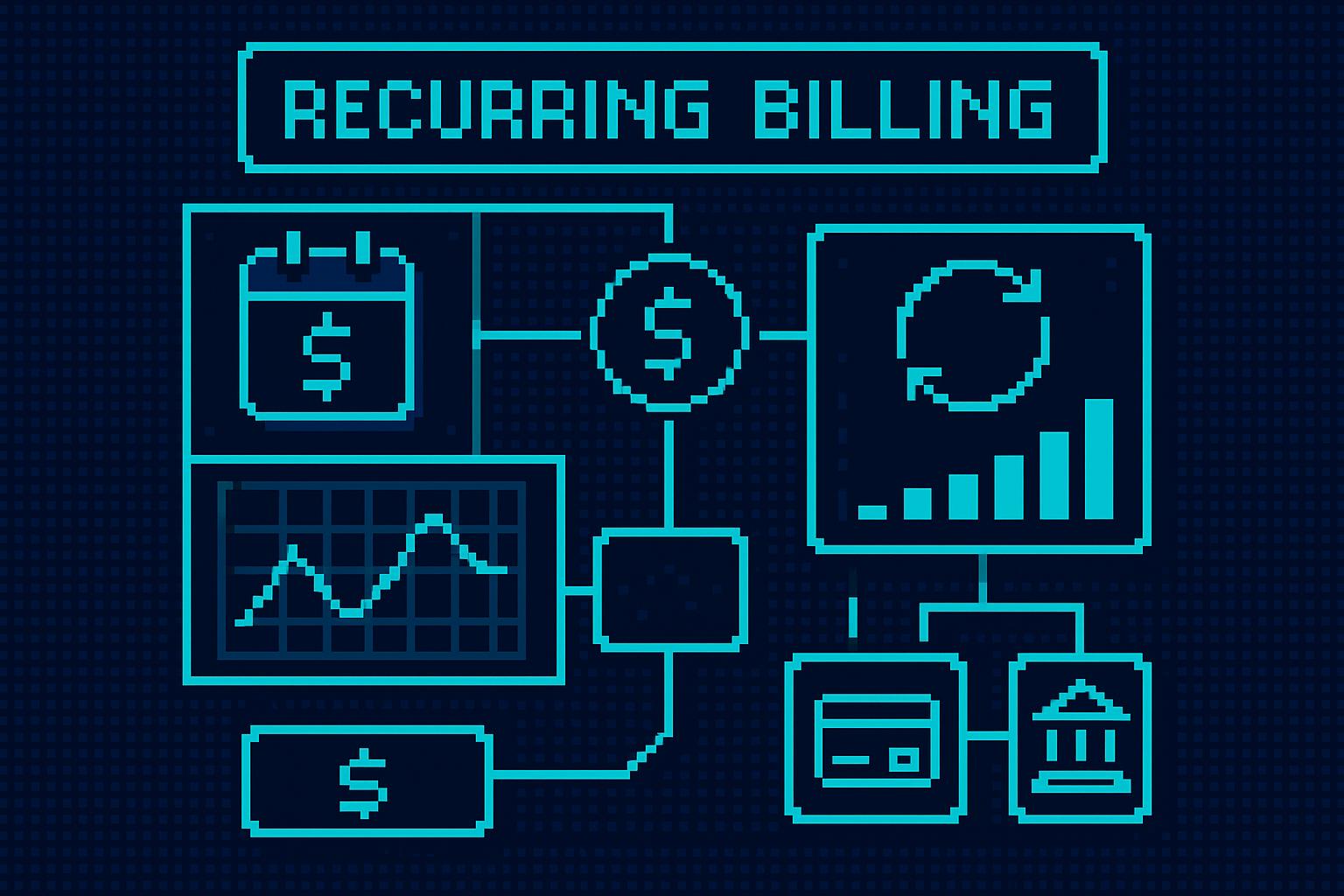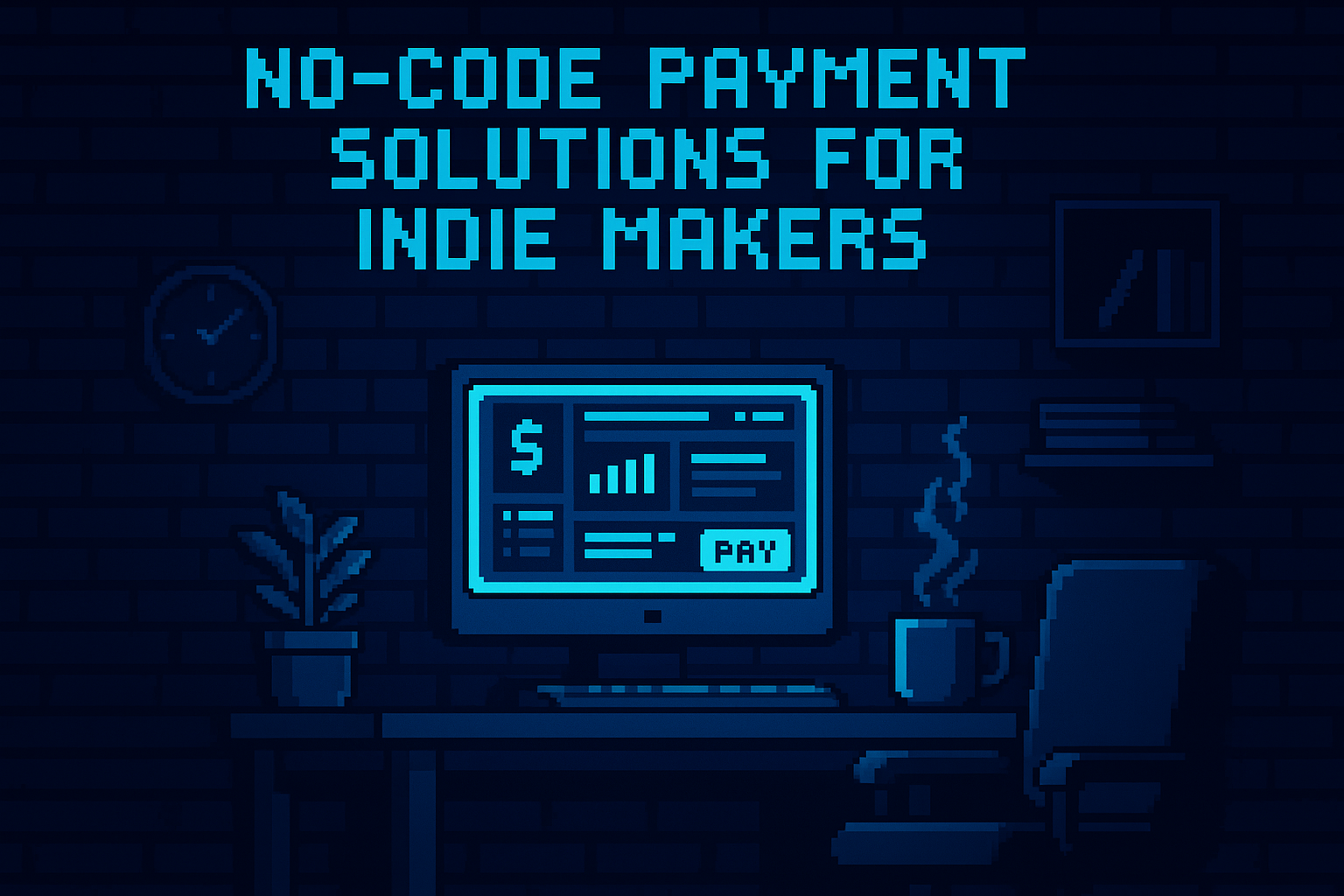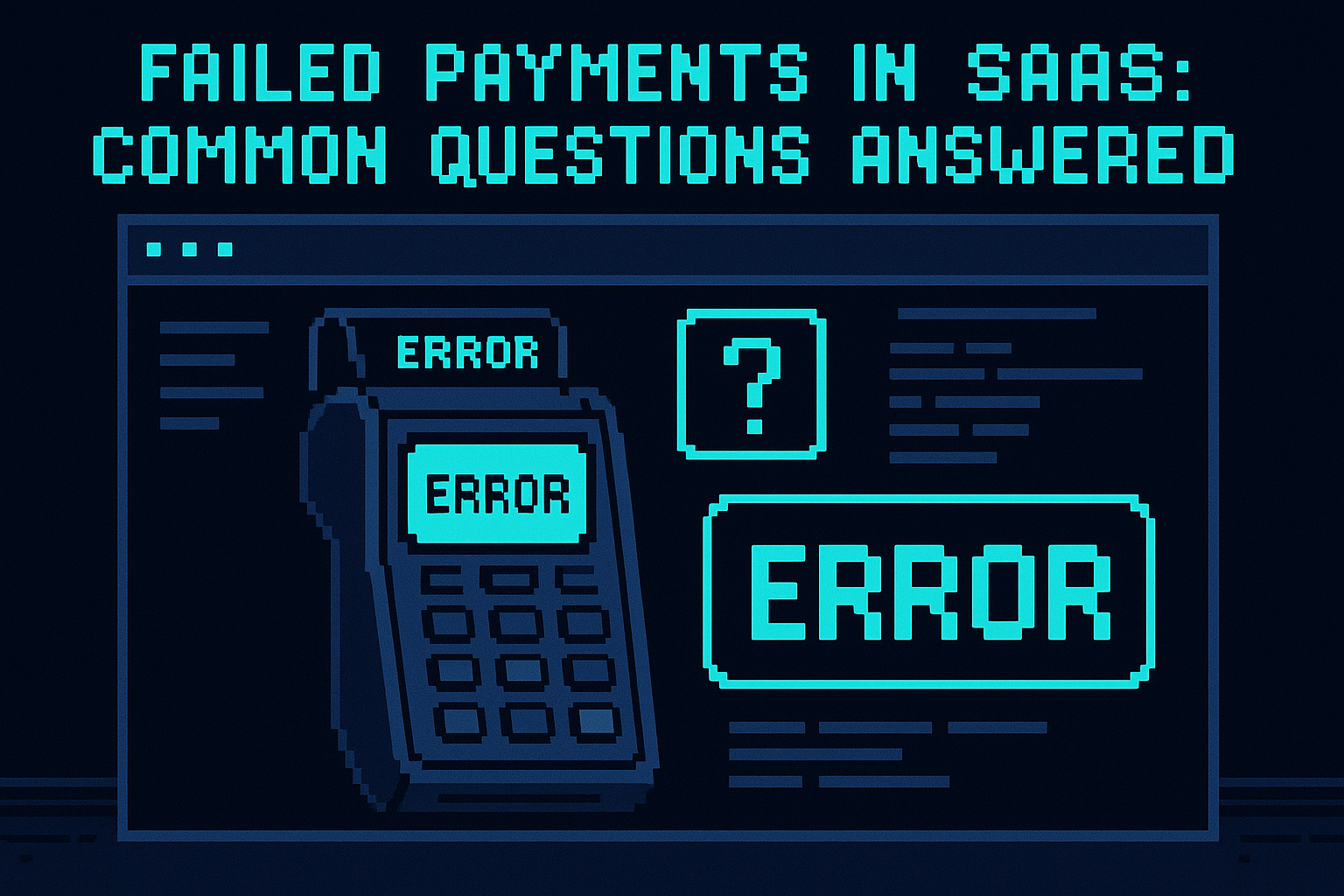Mobile payment APIs are essential for SaaS businesses to manage transactions, subscriptions, and compliance. Choosing the right API can save costs, streamline operations, and support growth. This article compares five popular options - Stripe, Adyen, PayPal for Marketplaces, LemonSqueezy, and Paddle - based on their features, pricing, and ease of use.
Key Highlights:
- Stripe: Best for developers and global SaaS businesses. Offers flexible tools for complex billing but may be challenging for non-technical users.
- Adyen: Ideal for large enterprises with global operations. Requires significant development resources but provides strong international support.
- PayPal for Marketplaces: Trusted brand with multi-vendor support. Limited customization and higher fees.
- LemonSqueezy: Simplifies billing for smaller SaaS companies. Higher transaction fees but includes tax handling.
- Paddle: Great for global SaaS with built-in tax compliance. Fewer customization options but simplifies subscription management.
Quick Comparison:
| Provider | Best For | Transaction Fees | Key Advantage | Main Drawback |
|---|---|---|---|---|
| Stripe | Developer-focused SaaS | 2.9% + $0.30 | Flexible and global reach | Technical complexity |
| Adyen | Enterprise SaaS | Custom pricing | Global processing | High implementation cost |
| PayPal | Multi-sided platforms | 2.9% + $0.30 | Brand trust | Limited customization |
| LemonSqueezy | Simple SaaS products | 5% + $0.50 | Tax handling included | Higher fees |
| Paddle | Global SaaS businesses | 5% + $0.50 | Built-in tax compliance | Fewer advanced features |
Each API has unique strengths. Stripe and Adyen suit larger, resource-heavy teams, while LemonSqueezy and Paddle cater to smaller SaaS businesses. PayPal works well for marketplaces. Evaluate your priorities - technical flexibility, simplicity, or global scalability - before deciding.
How to Choose the Best Payment Processor: Stripe, PayPal, or Merchant Account?
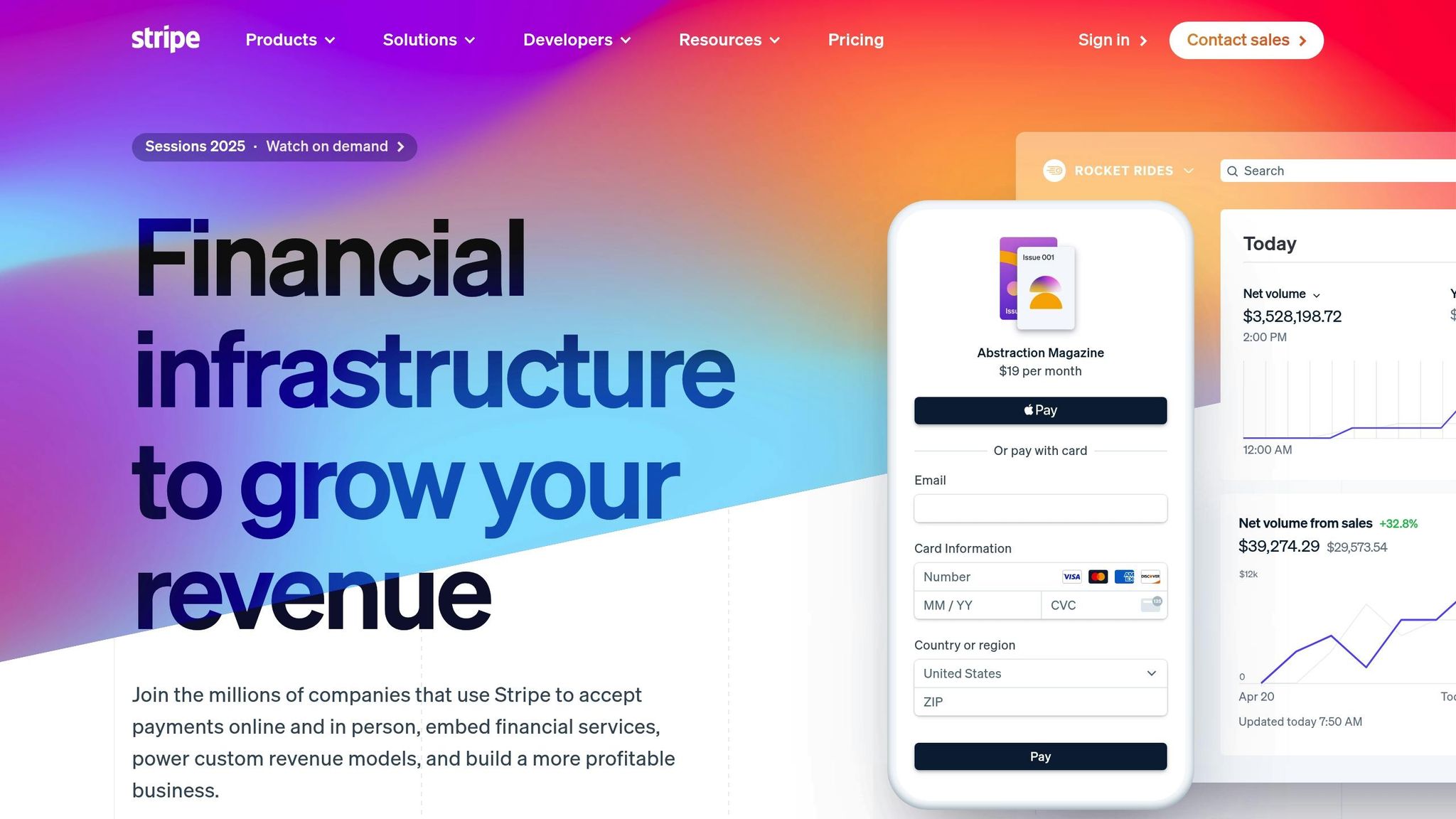
1. Stripe
Stripe is a popular API designed for SaaS businesses, offering tools that handle everything from straightforward transactions to intricate subscription models. Known for its ability to process large volumes and support a wide range of industries, Stripe has become a go-to solution for many SaaS providers.
Supported Payment Methods
Stripe supports a variety of payment methods, including digital wallets like Apple Pay, Google Pay, and Samsung Pay, as well as ACH direct debits for B2B payments. For global transactions, it offers local options such as SEPA Direct Debit, Alipay, and Bancontact. Beyond these, Stripe simplifies managing recurring revenue with advanced billing tools.
Recurring Billing and Subscription Management
Stripe excels in handling complex billing needs. Whether it's prorated upgrades, mid-cycle plan changes, usage-based billing, free trials, or automated retries, Stripe takes the hassle out of managing recurring revenue.
Stripe Billing includes features like automatic invoice generation, tax calculation across jurisdictions, and revenue recognition tools that align with accounting standards. These tools make it easier for companies to track key metrics like monthly and annual recurring revenue.
One standout feature is Smart Retries, which uses machine learning to optimize the timing of payment retries. This helps recover payments more effectively, reducing churn and boosting revenue.
Pricing
Stripe uses a pay-as-you-go pricing model, meaning there are no setup fees or monthly minimums. Standard transactions are charged based on a percentage of the transaction amount, plus a fixed fee. Additional charges apply for international transactions and currency conversions. For businesses with higher transaction volumes, Stripe offers custom pricing options. The Stripe Billing add-on provides advanced features like subscription management, automated invoicing, and revenue tracking.
Developer Integration
Stripe is known for being developer-friendly, offering detailed documentation, interactive API explorers, and pre-built UI components through Stripe Elements. These tools make it easy to integrate Stripe into web and mobile platforms, including support for iOS, Android, and React Native SDKs.
Developers can choose between pre-built checkout pages for quick setup or custom payment forms for more control over the user experience. The Stripe Elements library provides secure, customizable components that help businesses stay PCI compliant.
To enhance functionality, Stripe's webhook system delivers real-time notifications for events like payments, subscription updates, and failed transactions. This allows SaaS businesses to automate tasks like updating user access, sending alerts, or triggering other business processes. With these tools, Stripe ensures a smooth and reliable payment experience across digital and mobile platforms.
2. Adyen
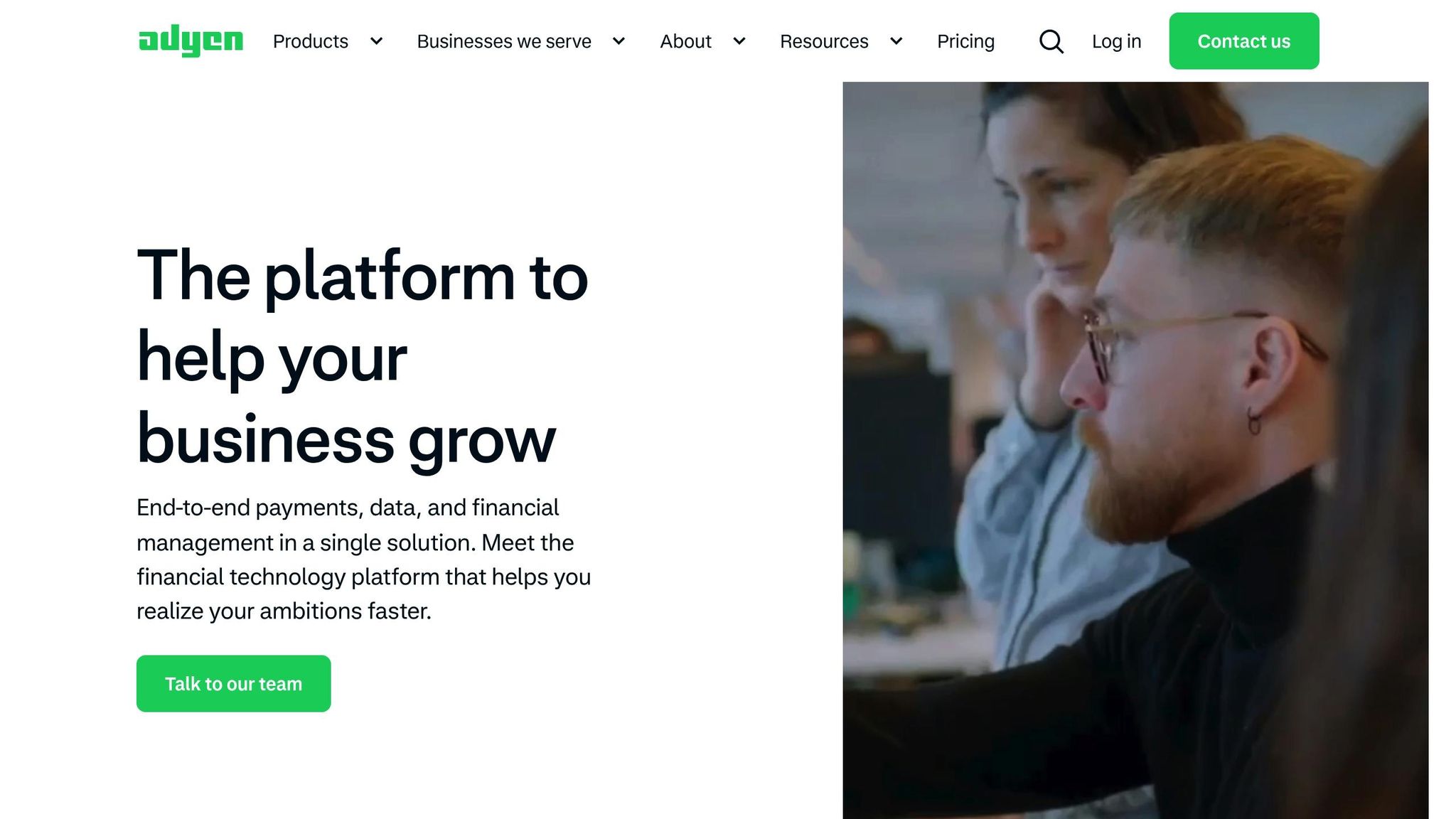
Adyen is a global payment platform that simplifies online, mobile, and in-person transactions through a single, unified system. It’s a strong choice for SaaS businesses needing a flexible payment solution.
Supported Payment Methods
Adyen supports a broad array of payment methods tailored to various markets. For mobile transactions, it integrates with popular options like Apple Pay, Google Pay, and Samsung Pay, as well as regional digital wallets such as WeChat Pay and Alipay. Beyond mobile, it handles traditional payment methods like credit and debit cards, bank transfers, and direct debits. What sets Adyen apart is its local acquiring capability, enabling it to process payments as a local entity in different countries. This often translates to higher approval rates and potentially lower costs for cross-border transactions.
Recurring Billing and Subscription Management
Adyen’s recurring billing features are built to manage the intricate subscription models often found in enterprise SaaS. The platform includes tools like automatic retries for failed payments and tokenization to securely store payment details. These features ensure a seamless subscription experience, allowing customers to update or manage their plans without the hassle of repeatedly entering payment information.
Pricing
Adyen uses an interchange-plus pricing model, where businesses pay the actual interchange fees plus a small markup. Processing fees depend on the payment method and region, with custom pricing available for larger enterprises. This pricing structure is particularly beneficial for businesses handling high transaction volumes.
Developer Integration
Adyen provides a robust set of tools for developers, including APIs and SDKs for both web and mobile platforms. Its native iOS and Android SDKs, along with a Web SDK featuring pre-built forms, enable secure in-app payments and adapt to the user’s location. A powerful webhook system delivers real-time updates on payment events, while a dedicated test environment replicates the live setup, allowing developers to test various scenarios before launch. These tools make Adyen a solid option for businesses looking to integrate mobile payment APIs efficiently.
3. PayPal for Marketplaces
PayPal for Marketplaces is specifically designed for marketplace and multi-vendor platforms, making it easier to split payments between platform owners and vendors. It ensures that payment processing aligns with compliance and security standards while simplifying how funds are distributed.
Supported Payment Methods
This solution supports payments through PayPal accounts, credit cards, and debit cards, covering over 200 markets and 25 currencies. Mobile users can take advantage of the PayPal mobile app or the one-touch checkout feature, which saves payment preferences for quicker future transactions. Additional options include PayPal Credit and Pay in 4, giving buyers more flexibility.
Recurring Billing and Subscription Management
PayPal automates recurring billing, including retrying failed payments based on predefined rules, ensuring a smoother subscription experience for users.
Pricing
For smaller transaction volumes, the fee structure is 2.9% + $0.30 per transaction, with potential adjustments for higher volumes. There are no monthly fees or setup costs, making it a practical choice for growing SaaS marketplaces.
Developer Integration
PayPal provides a robust set of tools for seamless integration into marketplaces. Its REST API supports both sandbox and live environments, allowing developers to test payment workflows thoroughly before going live. Native mobile SDKs for iOS and Android ensure smooth in-app payment experiences, while the webhooks system offers real-time updates on payment events and subscriptions.
To simplify vendor onboarding, the Partner Referrals API sends invitation links that guide sellers through the setup process. Additionally, PayPal can automatically split payments between the platform and vendors based on predefined rules, reducing manual effort and simplifying financial management.
sbb-itb-a989baf
4. LemonSqueezy
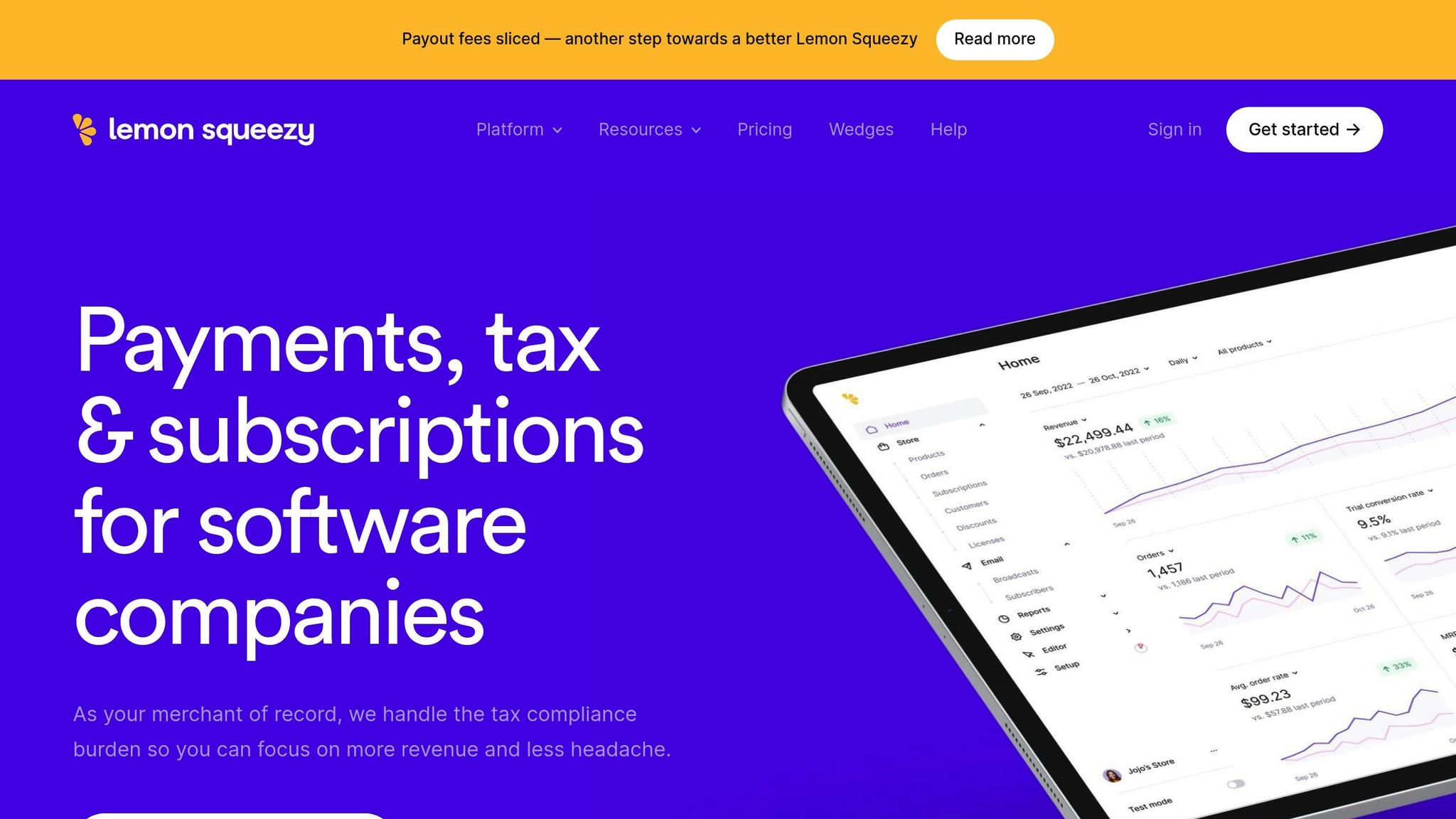
LemonSqueezy simplifies recurring billing and subscription management for SaaS businesses with an easy-to-use, automated platform. Its focus on simplicity ensures smooth subscription renewals without the need for extensive customization. The platform also uses a retry mechanism to reduce interruptions, helping keep subscriptions on track.
Supported Payment Methods
LemonSqueezy supports major credit and debit cards, along with mobile wallets like Apple Pay and Google Pay. It also integrates with PayPal, offering familiar payment options that can boost conversions, especially on mobile devices.
Recurring Billing and Subscription Management
The platform goes beyond basic billing by managing prorated upgrades, downgrades, and usage-based billing scenarios. It also takes care of generating invoices and calculating taxes across various jurisdictions. This makes it a practical choice for SaaS companies seeking robust billing features without the hassle of complex setups.
Pricing
LemonSqueezy uses a percentage-based pricing model with no monthly minimums or setup fees. Its transaction fees cover payment processing, tax handling, and fraud protection. This transparent pricing structure helps growing SaaS businesses manage costs effectively as they scale.
Developer Integration
For developers, LemonSqueezy provides straightforward integration options through its REST API and JavaScript SDK. It supports webhooks for real-time payment updates and includes a sandbox environment for testing. Developers can also use pre-built checkout components to embed payment functionality directly into web or mobile apps, saving valuable development time.
This streamlined approach sets the stage for examining how Paddle takes mobile payment solutions for SaaS to the next level.
5. Paddle

Paddle takes a straightforward approach to simplify billing for SaaS companies. By automating subscription management and payment retries, it allows businesses to focus on improving their core products rather than getting bogged down with billing complexities.
Supported Payment Methods
Paddle supports a variety of payment options, including major credit and debit cards, PayPal, Apple Pay, and Google Pay. It also accommodates regional payment methods like SEPA Direct Debit and bank transfers, making it a solid choice for SaaS companies operating in global markets.
Recurring Billing and Subscription Management
Managing subscriptions is a breeze with Paddle. The platform handles complex scenarios like prorated billing, plan upgrades or downgrades, and usage-based pricing. Its intelligent retry system automatically recovers failed payments, while customizable email sequences and payment recovery workflows help reduce involuntary churn through built-in dunning management.
Pricing
Paddle operates on a percentage-based pricing model with no upfront setup fees or monthly minimums. This fee covers payment processing, tax compliance, and fraud protection. For businesses with higher transaction volumes, Paddle offers discounts, making it an appealing option for scaling SaaS companies.
Developer Integration
With REST APIs and JavaScript SDKs, Paddle makes integration into web and mobile apps straightforward. Real-time subscription event notifications are managed through its webhook system, and a sandbox environment ensures you can thoroughly test your setup before going live. Additionally, pre-built checkout overlays and embedded forms save development time and come PCI-compliant right out of the box.
Advantages and Disadvantages
Choosing the right mobile payment API for your SaaS business means weighing the strengths and weaknesses of each option. The best choice depends on your specific needs, technical resources, and growth ambitions.
Stripe stands out for its developer-friendly approach, detailed documentation, and highly flexible APIs. Its global capabilities make it an excellent option for SaaS businesses aiming to expand internationally. However, its complexity can be a hurdle for non-technical founders, and managing tax compliance typically requires additional tools.
Adyen offers enterprise-grade reliability and seamless global payment processing. It’s a great fit for large SaaS companies that need advanced fraud detection and detailed analytics. On the flip side, it’s not beginner-friendly - it demands significant development resources and may be overkill for smaller businesses.
PayPal for Marketplaces benefits from PayPal’s trusted name, which can boost customer conversion rates. It’s particularly useful for SaaS platforms facilitating transactions between users. That said, it comes with limited customization options, higher fees, and a dependency on PayPal's ecosystem.
LemonSqueezy simplifies payments by including tax handling out of the box, making it ideal for SaaS founders who want to focus on building their product rather than managing payment systems. The downside? Higher transaction fees and less flexibility for more complex billing needs.
Paddle strikes a balance between simplicity and strong subscription management features. It handles tax compliance and supports global sales, making it a compelling choice for SaaS companies targeting international markets. However, its higher transaction fees can cut into profits, and it offers fewer advanced customization options compared to Stripe.
Here’s a quick comparison of the key features, fees, and trade-offs for each provider:
| Provider | Best For | Transaction Fees | Key Advantage | Main Drawback |
|---|---|---|---|---|
| Stripe | Developer-focused SaaS | 2.9% + $0.30 | Flexibility and global reach | Technical complexity |
| Adyen | Enterprise SaaS | Custom pricing | Unified global processing | High implementation barrier |
| PayPal for Marketplaces | Multi-sided platforms | 2.9% + $0.30 | Brand trust and recognition | Limited customization |
| LemonSqueezy | Simple SaaS products | 5% + $0.50 | All-in-one simplicity | Higher fees |
| Paddle | Global SaaS businesses | 5% + $0.50 | Tax compliance included | Higher transaction costs |
When deciding, consider your business size, technical expertise, and operational complexity. Smaller SaaS companies often gravitate toward the simplicity of LemonSqueezy or Paddle. Larger teams with technical resources may prefer the flexibility of Stripe or the enterprise capabilities of Adyen. PayPal is a strong choice for SaaS platforms where marketplace functionality or brand recognition plays a critical role in conversions.
For more in-depth guidance, check out Choose a Payment Provider for Your SaaS.
Conclusion
Choosing the right mobile payment API for your SaaS business hinges on understanding your unique needs, technical capabilities, and growth goals. Payment providers differ widely in their features, pricing structures, and the types of businesses they cater to.
Each option has its strengths. Stripe stands out for SaaS businesses that value flexibility and have the technical expertise to manage complex payment flows. With its competitive pricing and API designed for global scalability, Stripe works well for companies with international customers or advanced billing requirements.
For larger enterprises, Adyen offers unified global payment processing paired with robust security features. While it may require more upfront development effort, its enterprise-grade infrastructure makes it a solid choice for businesses with extensive operations.
PayPal for Marketplaces leverages its strong brand recognition to boost conversion rates, particularly for platforms that handle peer-to-peer transactions. Its familiar checkout process often reduces cart abandonment, though it offers less flexibility in terms of customization.
If your focus is on product development rather than managing billing systems, LemonSqueezy and Paddle provide a more streamlined solution. These platforms handle tax compliance and subscription management automatically, saving time and simplifying operations for SaaS founders.
Ultimately, the best payment API for your business depends on your priorities - whether it’s control, cost efficiency, or scalability. Startups may find the simplicity of LemonSqueezy or Paddle appealing, while growing SaaS companies might prefer the flexibility of Stripe or the enterprise capabilities of Adyen.
For more detailed guidance and tailored comparisons for SaaS businesses in the U.S., check out Choose a Payment Provider for Your SaaS. This resource offers feature-based filters to help you make the best decision for your business.
FAQs
What are the differences in transaction fees and pricing models for SaaS businesses using Stripe, Adyen, PayPal, LemonSqueezy, and Paddle?
Transaction fees and pricing structures differ widely across payment providers for SaaS businesses. Here’s a quick breakdown:
- Stripe: Charges 2.9% + $0.30 per transaction with no setup or monthly fees, making it a versatile choice for businesses of all sizes.
- LemonSqueezy: Applies a flat fee of 5% + $0.50 per transaction, which can be a practical option for smaller businesses or niche markets.
- Adyen: Offers customized pricing based on transaction volume and specific business requirements, catering to larger enterprises with more complex needs.
- PayPal: Typically charges 2.9% + $0.30 per transaction, though extra fees may apply for services like cross-border payments.
- Paddle: Has a 5% + $0.50 per transaction fee, but it also takes care of taxes and compliance, streamlining operations for SaaS providers.
When deciding on a payment provider, think about factors like your transaction volume, whether you sell internationally, and the unique requirements of your SaaS business. These considerations can help you identify the provider that aligns best with your needs.
What should a SaaS company consider when choosing between a developer-centric API like Stripe and a user-friendly option like LemonSqueezy?
When choosing between a developer-focused option like Stripe and a more user-friendly platform such as LemonSqueezy, SaaS companies need to weigh their priorities and resources carefully.
Stripe offers incredible flexibility, catering to businesses that have technical expertise and require advanced customization. Its robust integration tools make it a go-to choice for teams that want full control over their payment processes and are equipped to handle the technical demands.
On the other hand, LemonSqueezy takes a more hands-off approach by serving as a Merchant of Record. This means it handles critical tasks like tax calculation, collection, and remittance for you. For companies aiming to simplify compliance and reduce administrative tasks, this can be a huge time-saver.
The decision ultimately hinges on what your SaaS business values most: the ability to customize and control through developer tools or a simpler, ready-to-go solution with built-in tax management. Assess your team's technical capabilities and operational needs to make the best choice.
How do payment APIs manage international transactions and tax compliance for SaaS businesses operating globally?
For SaaS businesses with a global reach, having payment APIs that handle multiple currencies and diverse payment methods is a game-changer for boosting customer conversion rates. Equally important, these APIs must comply with local tax laws and regulations, which helps simplify operating across different regions.
Many payment APIs come equipped with features like multi-currency support, automated tax calculations, and comprehensive reporting tools. These functionalities can make managing revenue, tax reporting, and compliance far more efficient, cutting down on errors and saving valuable time when dealing with international transactions.
